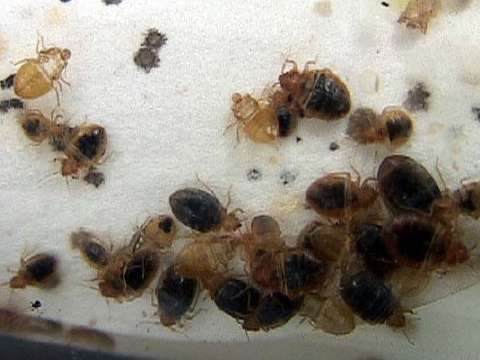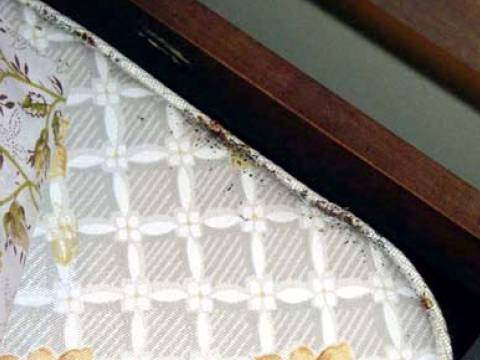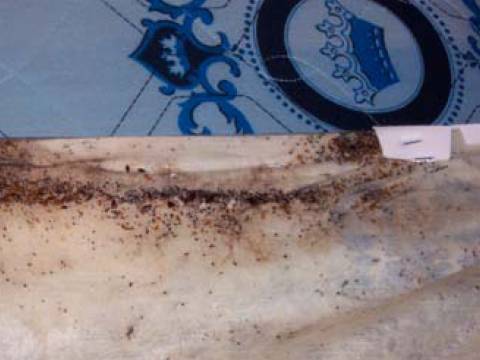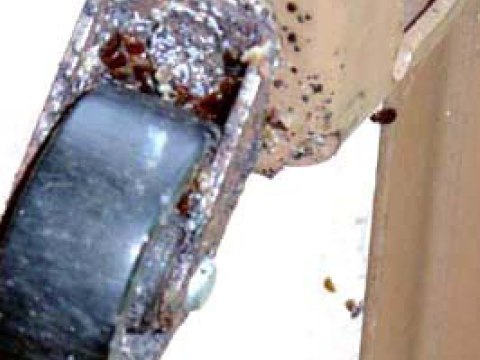Bed bugs are small and really good at finding places to hide. They are not too small to be seen though, as many people mistakenly believe. You can see adult bed bugs with the naked eye. And you can also see their signs: feces and molted exoskeletons.
But you might not be sure exactly what you’re looking for. Even after seeing the many pictures on this site, you still might be thinking:
Would I even recognize a bed bug if I saw one?
The pictures on this page show you some places to look for bed bugs and what you might see. They should help you recognize bed bugs if you come across them.
Group of Bed Bugs
This picture shows bed bugs at different life stages as well as molted exoskeletons. 
Image credit: University of Minnesota Entomology
Bed bugs are gregarious in nature–they often hide together in groups.
Bed Bugs in Seam of Backpack
Look at how the bed bugs hide in the seams of this backpack. Also note the size in relation to the zipper and fingers of the person showing the backpack. Bed bugs are good hitchhikers. This is why it is so important to take precautions. 
Image credit: University of Minnesota Entomology
To clean up a backpack like this, vaccuum the bed bugs off of it into a bag-style vacuum. (Treat the vacuum bag with diatomaceous earth to kill bed bugs.) Then throw the backpack into the dryer on high for a while.
Bed Bugs and Bed Bugs Feces on Mattress Seam
Bed bugs hide close to where people sleep because that is where bed bugs feed. They hide their flat bodies in crevices like the seam of this mattress. This is also the place to look for bed bugs during the initial stage of an infestation. 
Image credit: University of Minnesota Entomology
Before staying in a hotel, motel or hostel, look for signs of a bed bug infestation by inspecting the mattress, box spring and headboard.
Bed Bugs and Bed Bugs Feces on Box Spring
Although it is cumbersome to inspect the box spring, this is a good place to check for a bed bug infestation. The underside of this box spring shows a large amount of bed bugs along with fecal stains. 
Image credit: University of Minnesota Entomology
Rips in the box spring can be problematic because bed bugs may simply infest it on the inside making detection more difficult.
Bed Bugs on Bed Frame
Although bed bugs will be found more often on wood and fabric than metal, this metal bed frame shows signs of bed bug infestation. 
Image credit: University of Minnesota Entomology
Note the size of the bed bugs in relation to the frame casters (wheels).
Bed Bugs in Curtains
In the early stages of an infestation, bed bugs stay close to the bed. They can be very mobile though and spread throughout a dwelling into other areas. 
Image credit: University of Minnesota Entomology
Because bed bugs like seams, cracks and crevices, fabrics can make a possible hiding areas.
Bed Bugs on Clothing
Bed bugs have infested this sock. Note the size of the bugs in relation to the sock and the hand holding the sock. 
Image credit: University of Minnesota Entomology
This sock can be treated the same as the backpack: vacuum the bed bugs off and put the socks in the dryer on high heat.
Now you have a few more ideas where to check for bed bug infestations and what an infestation can look like.